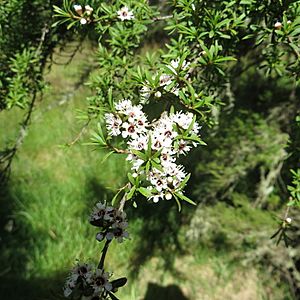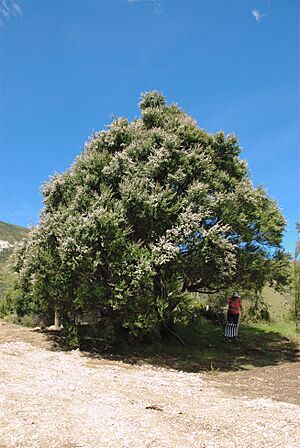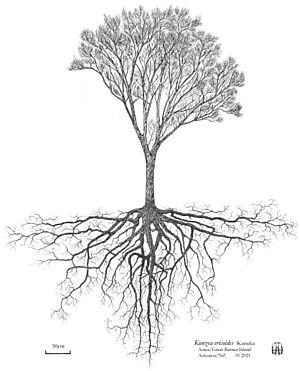Kānuka facts for kids
Quick facts for kids Kānuka |
|
|---|---|
 |
|
| Near Dunedin | |
| Scientific classification | |
| Genus: |
Kunzea
|
| Species: |
ericoides
|
| Synonyms | |
|
|
The Kunzea ericoides, often called kānuka or kanuka, is a special tree or bush found only in New Zealand. It belongs to the myrtle family. Kānuka has pretty white or pink flowers that look a lot like those of the Leptospermum plant. For a long time, from 1832 until 1983, people thought it was a type of Leptospermum. Its flowers have five petals and up to 25 stamens, which are usually longer than the petals.
Contents
What Kānuka Looks Like
Kānuka can be a spreading bush or a tree. It sometimes grows as tall as 18 m (60 ft), which is about the height of a two-story building! Its bark peels off in long strips, and its younger branches often hang down.
The leaves of the kānuka tree can be different shapes. They might be long and thin, or a bit wider like a spearhead. They are usually about 6.5–25 mm (0.3–1 in) long and 1–5 mm (0.04–0.2 in) wide.
Kānuka flowers are white or light pink. They grow close together on the side branches or near the top leaves. Each flower has a soft, fuzzy base and sits on a small stem about 3–6 mm (0.1–0.2 in) long. There are five small, triangular sepals and five petals, each about 2 mm (0.08 in) long. The flowers have up to 25 stamens, which are the parts that hold pollen. These stamens are usually longer than the petals, measuring 1–4 mm (0.04–0.2 in).
Kānuka trees bloom between October and February. After the flowers, small, cup-shaped fruits appear. These fruits are about 2–4 mm (0.08–0.2 in) long and wide. When they are ready, they usually open up to release their seeds.
Kānuka looks very similar to two Australian plants, K. leptospermoides and K. peduncularis. These were once thought to be the same as kānuka. However, a New Zealand botanist named Peter James de Lange studied them closely. He published a paper that showed how K. ericoides is different from these other plants.

How Kānuka Got Its Name
Kānuka was first officially described in 1832 by a French botanist named Achille Richard. He collected a sample in New Zealand and named it Leptospermum ericoides. This description was published in a book called Voyage de découvertes de l'Astrolabe - Botanique.
Later, in 1983, a botanist named Joy Thompson changed its name to Kunzea ericoides. She explained the differences between the Leptospermum and Kunzea groups of plants in a science journal called Telopea. The second part of its name, ericoides, means "likeness to Erica arborea". This is because the kānuka plant looks similar to the Erica arborea plant. The ending -oides is a Latin word part that means "likeness" or "similar to".
Where Kānuka Grows and Its Role in Nature
Kānuka, which was often called mānuka until the 1930s, is found all over New Zealand. You can see it from the Three Kings Islands and Aotea (Great Barrier Island) in the north, all the way down to Dunedin and Central Otago in the South Island, and even on Stewart Island. It is very common near Nelson.
Kānuka grows in many different places. It can be found in coastal areas, on sand dunes, and in lowland forests. Some types of kānuka can even grow high up in the mountains, reaching elevations of 2000 meters above sea level.
Kānuka is very important for the environment. It often grows on land that is recovering after a fire or land that was once used for farming and is now returning to its natural state. It helps the forest grow back. When kānuka blooms, its many small white flowers can cover a whole hillside, making it look like snow!
The wood from kānuka trees is very hard. Even though it doesn't last long if it's in the ground, people use it for things like wharf piles and tool handles. It's also a popular firewood because it burns with a lot of heat.
Kānuka trees can grow to about 10 meters tall. Kākāriki parakeets, which are a type of bird, use the leaves and bark of kānuka and its relative, the mānuka tea tree, to get rid of parasites. They eat some of the plant material, and they also chew it up, mix it with oil from a special gland, and rub it on their feathers.
Mānuka and kānuka look very similar, and people often get them confused. The easiest way to tell them apart is to feel their leaves. Kānuka leaves are soft, while mānuka leaves are prickly. Kānuka can also be found growing under larger trees like rimu and nothofagus in the South Island. Other plants that often grow near kānuka include crown fern and Cyathodes fasciculata.
Prostrate Kānuka
There is a special type of kānuka called prostrate kānuka (Kunzea ericoides var. microflora). This variety is one of the few plants that can survive in very hot ground near geothermal areas. These are places with hot springs and steam vents, like "Craters of the Moon" near Taupo, New Zealand.
Images for kids
See also
 In Spanish: Kanuka para niños
In Spanish: Kanuka para niños





